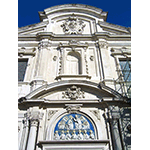Church of Ognissanti
The church of San Salvatore in Ognissanti was founded in the mid 13th century by the Humiliati, a religious order devoted to making and trading cloths. Establishing their convent on the banks of the River Arno is explained by the need to exploit hydraulic energy to activate the machines necessary to make woollen cloths. The location was strategic: at that point of the river, weirs had already been built in the early 13th century. Furthermore, close by stood the Ponte alla Carraia, the bridge built in 1218 to lessen the traffic on the till-then only existing bridge, from then on known as the Ponte Vecchio (literally Old Bridge). The arrival of the Humiliati brought the development of the district and the square, as well as the construction of new water-mills and fullers on the river bank.
The church and square lose their medieval look. In the 16th century, Cosimo I de’ Medici assigned the religious complex first to the Scopetini, and then to the Observant Minorites, and major refurbishing of the church was begun. Though conserving the Gothic architectural layout with a single aisle and raised transept, the interior presents a soberly Baroque decoration. The facade, too, is Baroque and was realised in 1637 on a project by architect Matteo Nigetti.
Though it was not a centre for scientific and astronomical studies, the church of Ognissanti conserves an interesting figurative testimony of what the study of a man of science might have looked like between the Middle Ages and the Renaissance. A detached fresco painted by Botticelli in 1480 and today on the right wall, portrays Saint Augustine in His Study. The work was realised in contraposition to Ghirlandaio’s Saint Jerome in His Study, today on the wall opposite. The Botticelli painting depicts the saint’s study employing all of the elements that, in the figurative repertory of the time, served to characterise a room destined to meditation and scientific speculation. The shelf behind the saint has numerous books, including an open volume with geometric figures referable to Euclid, and a mechanical clock indicating the I (First) hour after sunset. The study could not be without an armillary sphere, an astronomical instrument that usually represented the orbits of the planets and the Sun by means of armillas (rings), hinged around a common core. The one depicted in the painting reflects the geocentric vision of the universe, proper to the Ptolemaic system, with armillas indicating the principal celestial coordinates.
****************************
Texts by Graziano Magrini
English translation by Victor Beard
Last update 12/feb/2008




